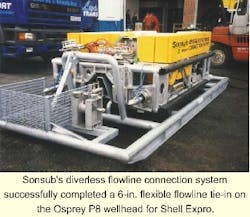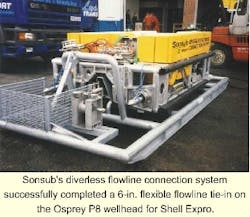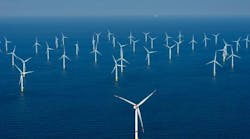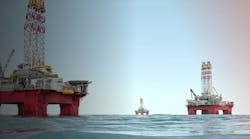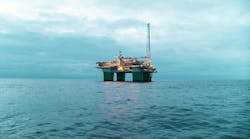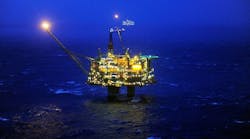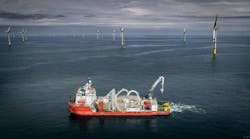Floating LNG study shows new hope
Bouygues Offshore recently completed a project called Azure R&D to look into the development of floating liquefied natural gas (LNG) facility concepts. Bouygues worked with nine other European companies including MW Kellogg, Chantiers de l'Atlantique, Fincantieri, FMC Europe, Gaz Transport & Technigaz, Bureau Veritas, Registro Itliano Navale, and Institut de Recherches de la Construction Navale. In addition, five oil producers contributed technical and financial support to the study.
The goal was to address all the technical issues involved in the floating LNG chain, from gas well to the gas distribution network. The program took place over 18 months and included designing a floating liquefaction plant, floating LNG terminals, and offshore LNG transfer systems. Each of the key components in the chain was then tested.
Denis Marchand, a spokesperson for Bouygues, said several of the oil producers involved have in-house studies underway to evaluate floating LNG. One of the key considerations for the study was how the motions of the barge would affect the LNG process. Marchand said this required a careful review of the heat exchangers and columns used on such a system.
For the study, it was assumed the process would be used in mild environments, such as offshore West Africa and South East Asia where there would be minimal weather-related downtime. While the first applications will be focused on benign environments (Marchand suggests the Timor Sea), long-term future applications of an LNG floating production, storage, and offloading (FPSO) unit will be the "base case" for the export of offshore gas reserves.
Based on the results of this study, Marchand said Bouygues is confident there will be an application of this design within the next several years. At this point Marchand claims, the concept is ready for front-end engineering and design (FEED) work.
The key to bringing this technology forward is to build on the now 20-year-old FPSO concept for storage and export offshore. Marchand said the use of an LNG containment system, in the form of a corrugated stainless steel membrane mounted on foam insulation panels, will allow for the storage and transportation of the product. Such a membrane system, designed by Technigaz, currently is used on 18 LNG tankers as well as 29 shore-based storage facilities. Other key technological challenges, according to Marchand, include:
- Safety during simultaneous operations of gas production, liquefaction, LNG storage, and export
- The Process, including plant marinization, the effect of motion, availability, and flexibility of the facilities
- LNG trans-shipment in open seas, including weather limitations, operability level, and naval means for tanker berthing and connection
- Liquid motion in tanks, which are always partially filled, and all the engineering tools for prediction and membrane design, which had to be developed and calibrated
- The feasibility of a concrete hull design.
The hull design was an open question at the beginning of the study, according to Marchand. The project looked at a steel hull design as well as the concrete concept. Bouygues advanced the concrete hull design, while the steel hull was developed by Chantiers de l'Atlantique.
Beyond the question of whether the concept is workable, is the question of its commercial application. Marchand emphasized that economics are typically site specific. Beyond that, the study points out that in situations where associated gas is the product in question, the gas is currently considered an expense, since the gas cannot be flared and the oil cannot be produced without somehow dealing with the gas.
Adding a liquefaction plant to a gas reservoir should add to the recoverable reserves, offsetting the additional cost. If deep ocean water is used for cooling produced gas, then the LNG production rate can be increased by 15%, Marchand said. An offshore LNG terminal can eliminate some of the regulatory headaches of trying to secure an onshore location for such a facility. Since the facility is floating, it can be relocated for both convenience and to further offset the cost of construction.
First diverless tie-in completed for Shell Expro
Sonsub's diverless flowline connection system (DFCS) successfully completed a 6-in. flexible flowline tie-in on the Osprey P8 wellhead for Shell UK E&P (Shell Expro). The operation was a "first-of-a-kind" for Shell Expro, according to Sonsub, since divers have completed all previous flexible flowline tie-ins. Sonsub's work class remotely operated vehicle DFCS was used on the project. The ROV allowed the system to be operated from the S-712 drilling rig during operations. This avoided the extra cost of securing a diving support vessel, which would necessarily make the operation more weather-dependent.
Other savings were gained by reducing interfaces into Shell's permanent hardware, which impacted the flowbase design/fabrication costs. Shell Expro has now selected DFCS interfaces as a standard for future flowbases requiring diverless flexible flowline tie-in operations.
Na Kika to be moored in record depths
ScanRope AS of Tonsberg, Norway has received confirmation from Shell that it was selected to manufacture and supply the steel strand mooring lines and accessories for Shell's Na Kika floating production unit in the Gulf of Mexico. The contract, including spare segments, will require about 3,000 metric tons, which makes it the largest single mooring contract to date for any manufacturer.
Because the Na Kika semisubmersible will be moored in 6,400-ft water depths, it will represent a record depth for a moored production system. The design of the mooring lines includes heavy-duty plastic jacketing. This will ensure the required lifetime capacity of at least 20 years. This jacket is applied in line at ScanRope's facility and the steel strands will be manufactured at ScanRope's production line in Tonsberg. The facility provided mooring lines for Åsgard B, Åsgard C, and Snorre B, all on the Norwegian continental shelf. Na Kika is the company's first contract in the US market for this particular product type. ScanRope said it considers the Gulf of Mexico to be the most promising market for deepwater permanent mooring systems in the years to come. Delivery of the mooring lines will be March 2002, aboard one vessel.
